PORSCHE 911 GT3 2010 5.G Owners Manual
Manufacturer: PORSCHE, Model Year: 2010, Model line: 911 GT3, Model: PORSCHE 911 GT3 2010 5.GPages: 251, PDF Size: 14.33 MB
Page 201 of 251
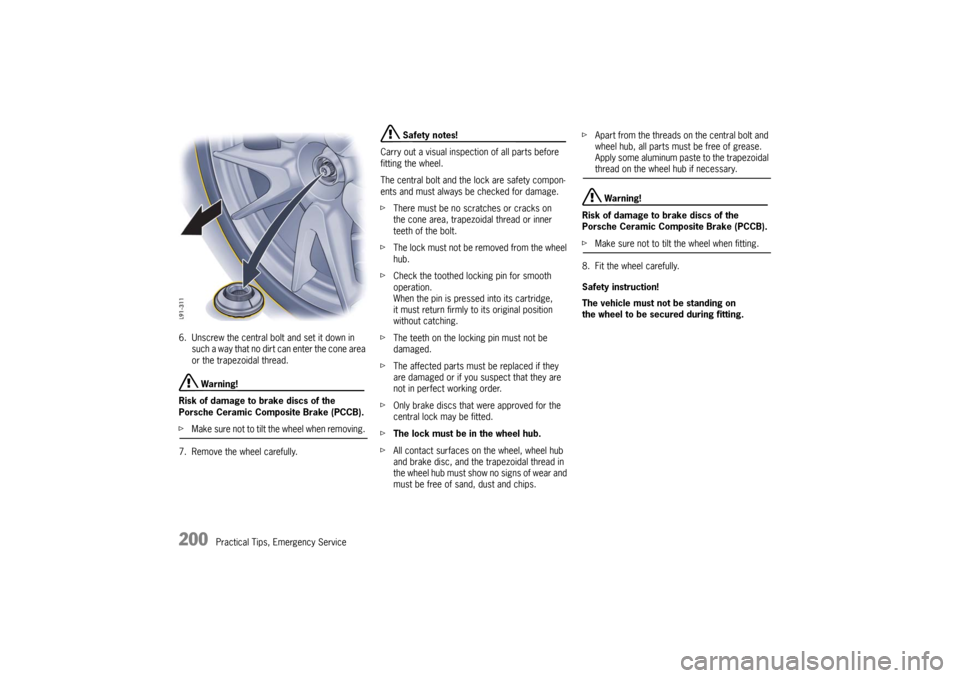
200
Practical Tips, Emergency Service 6. Unscrew the central bolt and set it down in
such a way that no dirt can enter the cone area
or the trapezoidal thread.
Warning!
Risk of damage to brake discs of the
Porsche Ceramic Composite Brake (PCCB).
fMake sure not to tilt the wheel when removing.
7. Remove the wheel carefully.
Safety notes!
Carry out a visual inspection of all parts before
fitting the wheel.
The central bolt and the lock are safety compon-
ents and must always be checked for damage.
fThere must be no scratches or cracks on
the cone area, trapezoidal thread or inner
teeth of the bolt.
fThe lock must not be removed from the wheel
hub.
fCheck the toothed locking pin for smooth
operation.
When the pin is pressed into its cartridge,
it must return firmly to its original position
without catching.
fThe teeth on the locking pin must not be
damaged.
fThe affected parts must be replaced if they
are damaged or if you suspect that they are
not in perfect working order.
fOnly brake discs that were approved for the
central lock may be fitted.
fThe lock must be in the wheel hub.
fAll contact surfaces on the wheel, wheel hub
and brake disc, and the trapezoidal thread in
the wheel hub must show no signs of wear and
must be free of sand, dust and chips. fApart from the threads on the central bolt and
wheel hub, all parts must be free of grease.
Apply some aluminum paste to the trapezoidal
thread on the wheel hub if necessary. Warning!
Risk of damage to brake discs of the
Porsche Ceramic Composite Brake (PCCB).
fMake sure not to tilt the wheel when fitting.
8. Fit the wheel carefully.
Safety instruction!
The vehicle must not be standing on
the wheel to be secured during fitting.
10_GT3_21.book Seite 200 Donnerstag, 4. Juni 2009 12:48 12
Page 202 of 251
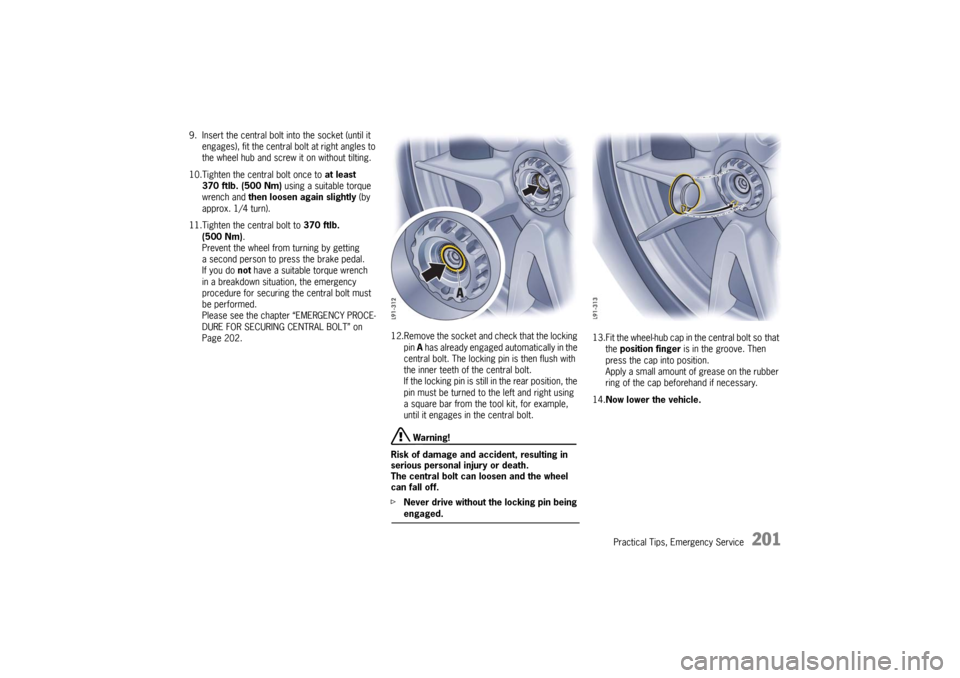
Practical Tips, Emergency Service
201
9. Insert the central bolt into the socket (until it
engages), fit the central bolt at right angles to
the wheel hub and screw it on without tilting.
10.Tighten the central bolt once to at least
370 ftlb. (500 Nm) using a suitable torque
wrench and then loosen again slightly (by
approx. 1/4 turn).
11.Tighten the central bolt to 370 ftlb.
(500 Nm).
Prevent the wheel from turning by getting
a second person to press the brake pedal.
If you do not have a suitable torque wrench
in a breakdown situation, the emergency
procedure for securing the central bolt must
be performed.
Please see the chapter “EMERGENCY PROCE-
DURE FOR SECURING CENTRAL BOLT” on
Page 202.12.Remove the socket and check that the locking
pin A has already engaged automatically in the
central bolt. The locking pin is then flush with
the inner teeth of the central bolt.
If the locking pin is still in the rear position, the
pin must be turned to the left and right using
a square bar from the tool kit, for example,
until it engages in the central bolt.
Warning!
Risk of damage and accident, resulting in
serious personal injury or death.
The central bolt can loosen and the wheel
can fall off.
fNever drive without the locking pin being engaged. 13.Fit the wheel-hub cap in the central bolt so that
the position finger is in the groove. Then
press the cap into position.
Apply a small amount of grease on the rubber
ring of the cap beforehand if necessary.
14.Now lower the vehicle.
10_GT3_21.book Seite 201 Donnerstag, 4. Juni 2009 12:48 12
Page 203 of 251
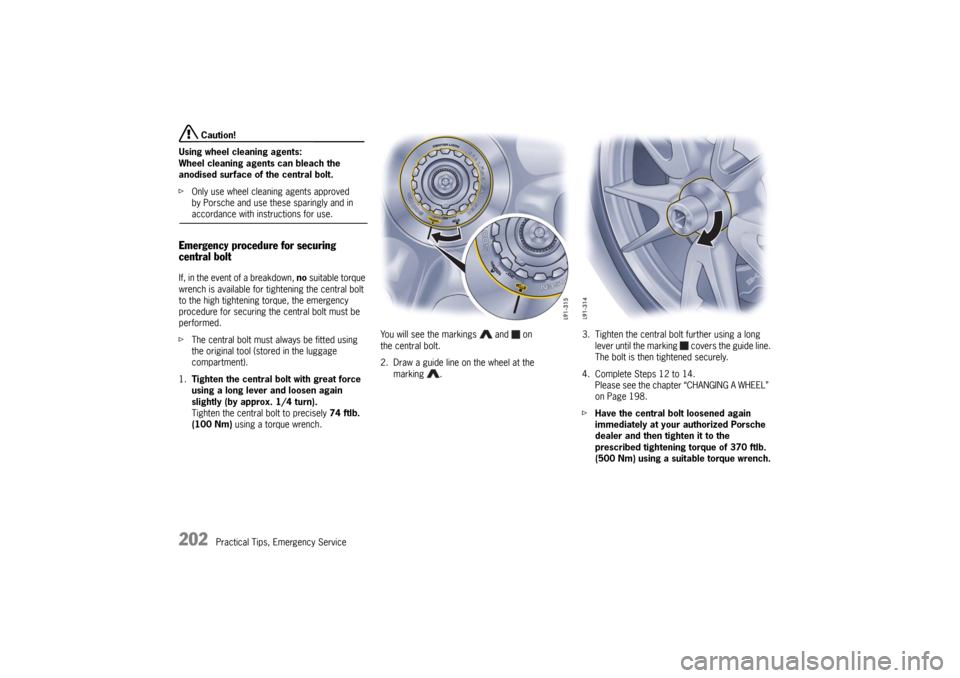
202
Practical Tips, Emergency Service
Caution!
Using wheel cleaning agents:
Wheel cleaning agents can bleach the
anodised surface of the central bolt.
fOnly use wheel cleaning agents approved
by Porsche and use these sparingly and in accordance with instructions for use.
Emergency procedure for securing
central boltIf, in the event of a breakdown, no suitable torque
wrench is available for tightening the central bolt
to the high tightening torque, the emergency
procedure for securing the central bolt must be
performed.
fThe central bolt must always be fitted using
the original tool (stored in the luggage
compartment).
1.Tighten the central bolt with great force
using a long lever and loosen again
slightly (by approx. 1/4 turn).
Tighten the central bolt to precisely 74 ftlb.
(100 Nm) using a torque wrench.You will see the markings and on
the central bolt.
2. Draw a guide line on the wheel at the
marking .3. Tighten the central bolt further using a long
lever until the marking covers the guide line.
The bolt is then tightened securely.
4. Complete Steps 12 to 14.
Please see the chapter “CHANGING A WHEEL”
on Page 198.
fHave the central bolt loosened again
immediately at your authorized Porsche
dealer and then tighten it to the
prescribed tightening torque of 370 ftlb.
(500 Nm) using a suitable torque wrench.10_GT3_21.book Seite 202 Donnerstag, 4. Juni 2009 12:48 12
Page 204 of 251

Practical Tips, Emergency Service
203
Checking Tire Pressure with a
Pressure Gauge1. Remove the valve stem cap from the tire.
2. Press the pressure gauge onto the valve stem.
Note on operation
fDo not press too hard or force the valve stem
sideways, or air will escape.
If the sound of air escaping from the tire is
heard, reposition the pressure gauge.
3. Read the tire pressure on the gauge stem and
compare it to the permissble tire pressure.
This information can be found on the tire
pressure plate or in the chapter Technical
Data.
Please see the chapter “TIRE PRESSURES FOR
COLD TIRES 68 °F/20 °C” on Page 237.
4. Remove the pressure gauge.
fPlease see the chapter “TPM TIRE PRESSURE
MONITORING” on Page 134.
Flat Tire
Warning!
Failure to follow these instructions may result
in serious personal injury to you or to bystan-
ders.
fIf you have a flat tire, move a safe distance off
the road. Turn the emergency flasher on and
use other warning devices to alert other
motorists. Set the parking brake.
fDo not park your vehicle where it may contact
dry grass, brush or other flammable materials.
The hot parts of the exhaust system could set
such materials on fire, thereby causing both
property damage and serious personal injury or death.
A tire sealant and compressor with pressure
tester are located in the luggage compartment.
fPlease see the safety and operating instruc-
tions on the special sealant bottle with a
special Porsche part number and on the
compressor – these are essential.Important note
Sealing the tire with the tire repair kit is only
an emergency repair. Even with the tire air-
t i g h t , i t m a y b e u s e d o nly for short trips in an
emergency.
The maximum permitted speed is 50 mph
(80 km/h).
fDo not use commercially available sealant or
tire inflating bottles.
Use only the tire sealant located in the luggage
compartment.
Warning!
Risk of accident, resulting in serious
personal injury or death.
fHave tires replaced by a specialist workshop
as soon as possible.
fAvoid hard acceleration and high cornering speeds.
10_GT3_21.book Seite 203 Donnerstag, 4. Juni 2009 12:48 12
Page 205 of 251
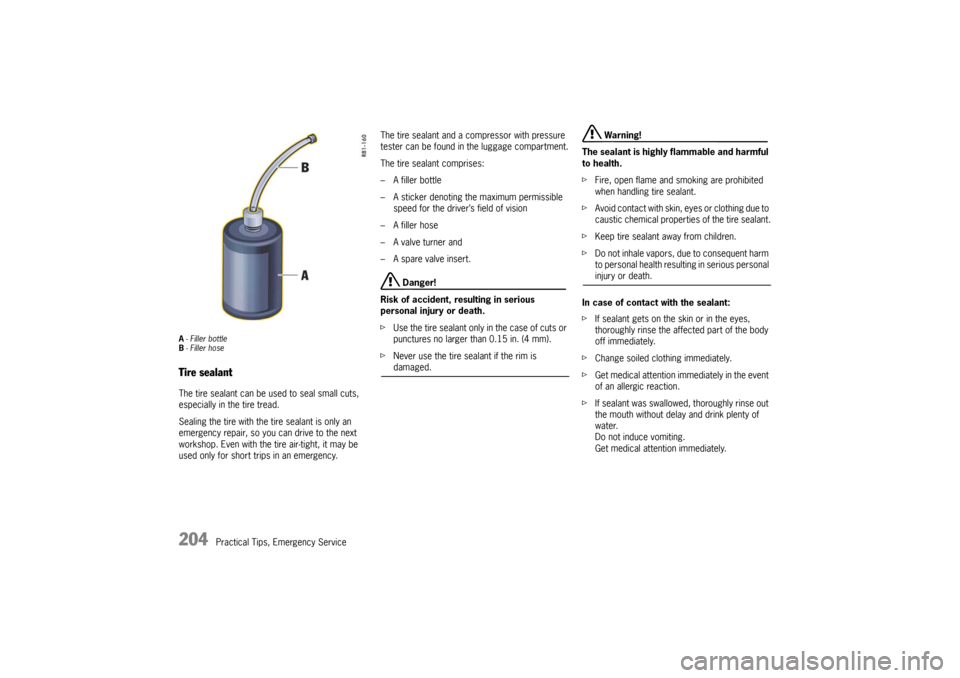
204
Practical Tips, Emergency Service
A- Filler bottle
B- Filler hoseTire sealantThe tire sealant can be used to seal small cuts,
especially in the tire tread.
Sealing the tire with the tire sealant is only an
emergency repair, so you can drive to the next
workshop. Even with the tire air-tight, it may be
used only for short trips in an emergency.The tire sealant and a compressor with pressure
tester can be found in the luggage compartment.
The tire sealant comprises:
– A filler bottle
– A sticker denoting the maximum permissible
speed for the driver’s field of vision
– A filler hose
– A valve turner and
– A spare valve insert.
Danger!
Risk of accident, resulting in serious
personal injury or death.
fUse the tire sealant only in the case of cuts or
punctures no larger than 0.15 in. (4 mm).
fNever use the tire sealant if the rim is damaged.
Warning!
The sealant is highly flammable and harmful
to health.
fFire, open flame and smoking are prohibited
when handling tire sealant.
fAvoid contact with skin, eyes or clothing due to
caustic chemical properties of the tire sealant.
fKeep tire sealant away from children.
fDo not inhale vapors, due to consequent harm
to personal health resulting in serious personal injury or death.
In case of contact with the sealant:
fIf sealant gets on the skin or in the eyes,
thoroughly rinse the affected part of the body
off immediately.
fChange soiled clothing immediately.
fGet medical attention immediately in the event
of an allergic reaction.
fIf sealant was swallowed, thoroughly rinse out
the mouth without delay and drink plenty of
water.
Do not induce vomiting.
Get medical attention immediately.
10_GT3_21.book Seite 204 Donnerstag, 4. Juni 2009 12:48 12
Page 206 of 251
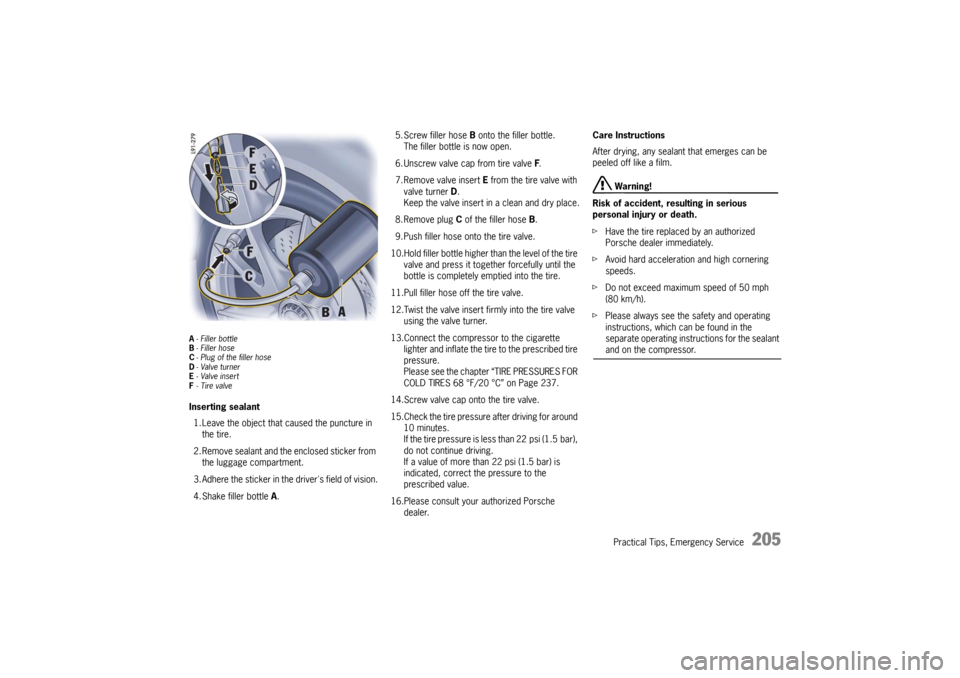
Practical Tips, Emergency Service
205
A- Filler bottle
B- Filler hose
C- Plug of the filler hose
D-Valve turner
E-Valve insert
F- Tire valveInserting sealant
1. Leave the object that caused the puncture in
the tire.
2. Remove sealant and the enclosed sticker from
the luggage compartment.
3. Adhere the sticker in the driver's field of vision.
4. Shake filler bottle A.5. Screw filler hose B onto the filler bottle.
The filler bottle is now open.
6. Unscrew valve cap from tire valve F.
7. Remove valve insert E from the tire valve with
valve turner D.
Keep the valve insert in a clean and dry place.
8. Remove plug C of the filler hose B.
9. Push filler hose onto the tire valve.
10.Hold filler bottle higher than the level of the tire
valve and press it together forcefully until the
bottle is completely emptied into the tire.
11.Pull filler hose off the tire valve.
12.Twist the valve insert firmly into the tire valve
using the valve turner.
13.Connect the compressor to the cigarette
lighter and inflate the tire to the prescribed tire
pressure.
Please see the chapter “TIRE PRESSURES FOR
COLD TIRES 68 °F/20 °C” on Page 237.
14.Screw valve cap onto the tire valve.
15.Check the tire pressure after driving for around
10 minutes.
If the tire pressure is less than 22 psi (1.5 bar),
do not continue driving.
If a value of more than 22 psi (1.5 bar) is
indicated, correct the pressure to the
prescribed value.
16.Please consult your authorized Porsche
dealer.Care Instructions
After drying, any sealant that emerges can be
peeled off like a film.
Warning!
Risk of accident, resulting in serious
personal injury or death.
fHave the tire replaced by an authorized
Porsche dealer immediately.
fAvoid hard acceleration and high cornering
speeds.
fDo not exceed maximum speed of 50 mph
(80 km/h).
fPlease always see the safety and operating
instructions, which can be found in the
separate operating instructions for the sealant and on the compressor.
10_GT3_21.book Seite 205 Donnerstag, 4. Juni 2009 12:48 12
Page 207 of 251
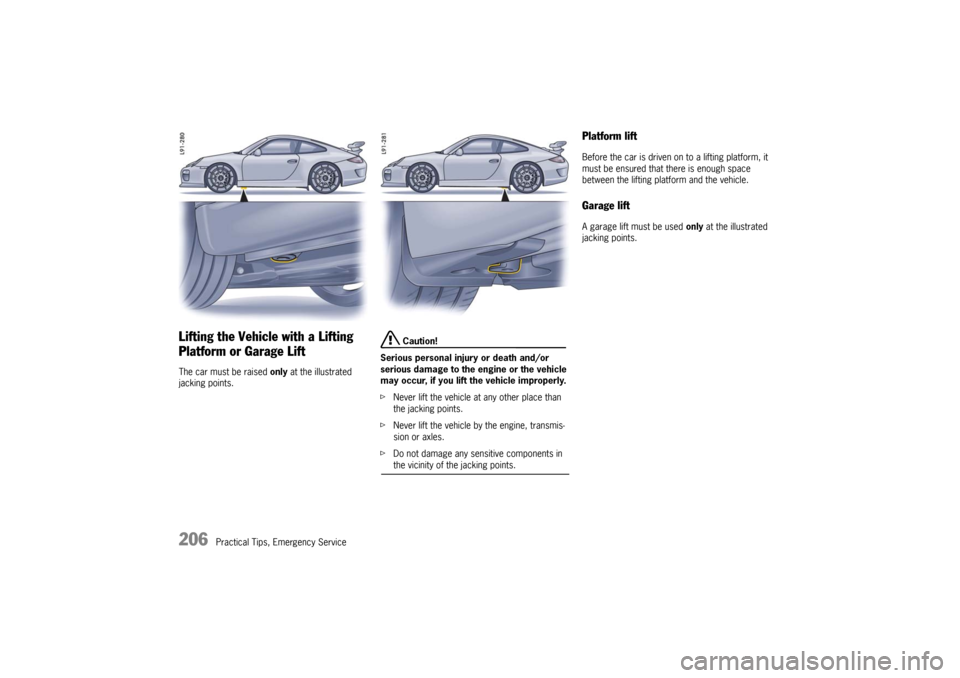
206
Practical Tips, Emergency Service
Lifting the Vehicle with a Lifting
Platform or Garage Lift The car must be raised only at the illustrated
jacking points.
Caution!
Serious personal injury or death and/or
serious damage to the engine or the vehicle
may occur, if you lift the vehicle improperly.
fNever lift the vehicle at any other place than
the jacking points.
fNever lift the vehicle by the engine, transmis-
sion or axles.
fDo not damage any sensitive components in the vicinity of the jacking points.
Platform lift Before the car is driven on to a lifting platform, it
must be ensured that there is enough space
between the lifting platform and the vehicle. Garage lift A garage lift must be used only at the illustrated
jacking points.
10_GT3_21.book Seite 206 Donnerstag, 4. Juni 2009 12:48 12
Page 208 of 251
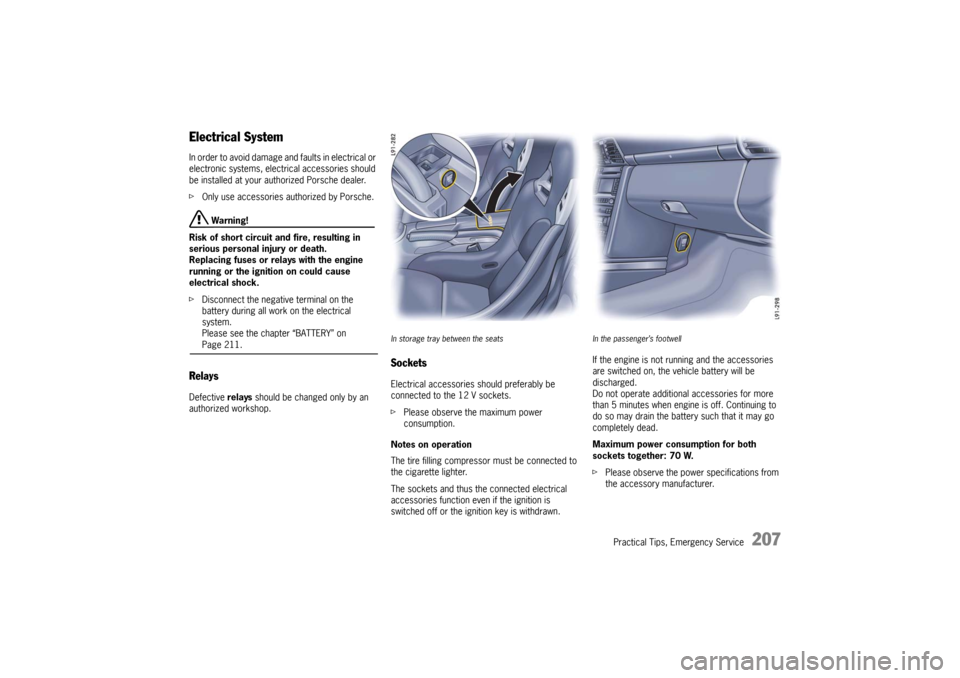
Practical Tips, Emergency Service
207
Electrical System In order to avoid damage and faults in electrical or
electronic systems, electrical accessories should
be installed at your authorized Porsche dealer.
fOnly use accessories authorized by Porsche.
Warning!
Risk of short circuit and fire, resulting in
serious personal injury or death.
Replacing fuses or relays with the engine
running or the ignition on could cause
electrical shock.
fDisconnect the negative terminal on the
battery during all work on the electrical
system.
Please see the chapter “BATTERY” on Page 211.
RelaysDefective relays should be changed only by an
authorized workshop.
In storage tray between the seatsSocketsElectrical accessories should preferably be
connected to the 12 V sockets.
fPlease observe the maximum power
consumption.
Notes on operation
The tire filling compressor must be connected to
the cigarette lighter.
The sockets and thus the connected electrical
accessories function even if the ignition is
switched off or the ignition key is withdrawn.
In the passenger’s footwellIf the engine is not running and the accessories
are switched on, the vehicle battery will be
discharged.
Do not operate additional accessories for more
than 5 minutes when engine is off. Continuing to
do so may drain the battery such that it may go
completely dead.
Maximum power consumption for both
sockets together: 70 W.
fPlease observe the power specifications from
the accessory manufacturer.
10_GT3_21.book Seite 207 Donnerstag, 4. Juni 2009 12:48 12
Page 209 of 251

208
Practical Tips, Emergency Service
Alarm system, central lockingThe status of the central locking and alarm system
is not changed by disconnecting the battery.
When the battery is disconnected, the alarm
system ceases to function.Central locking overload protectionIf the central locking system is operated more
than ten times within a minute, further operation is
blocked for 30 seconds.
Load switch-off after 2 hours or 7 daysIf the ignition key is removed, loads which are
switched on or are in standby mode (such as the
luggage compartment light, interior light and
radio) are automatically switched off after approx.
2hours.
If the vehicle is not started or unlocked with the
remote control within 7days, the remote control
standby function is switched off (to save the
vehicle battery).
1. In this case, unlock the driver’s door with the
key at the door lock.
Leave the door closed in order to prevent the
alarm system from being triggered.
2. Press button 1 on the remote control.
The remote control is now activated again.
10_GT3_21.book Seite 208 Donnerstag, 4. Juni 2009 12:48 12
Page 210 of 251
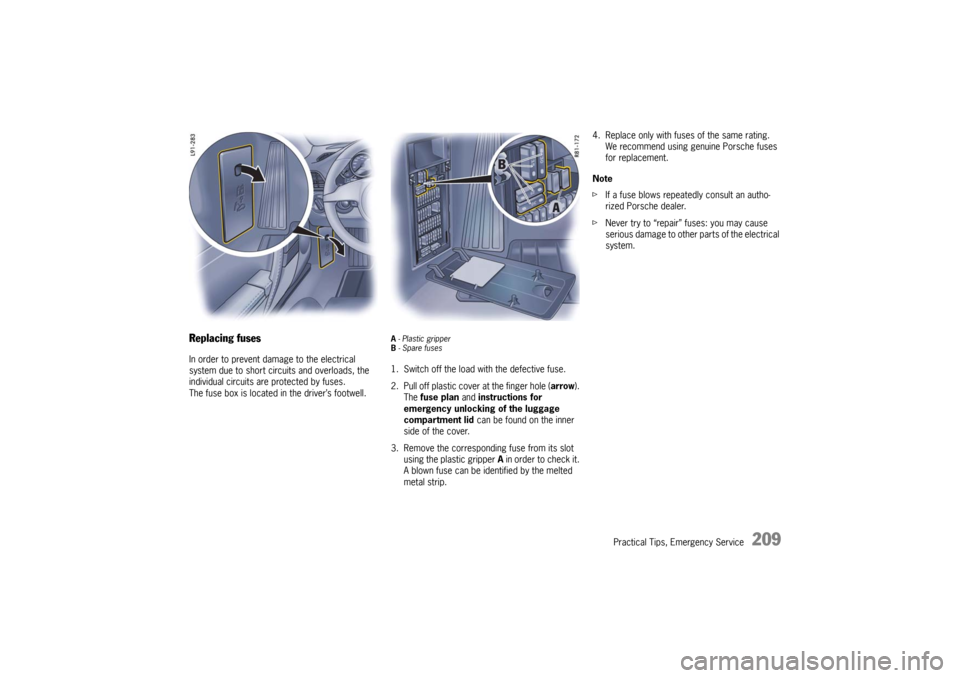
Practical Tips, Emergency Service
209
Replacing fuses In order to prevent damage to the electrical
system due to short circuits and overloads, the
individual circuits are protected by fuses.
The fuse box is located in the driver’s footwell.
A - Plastic gripper
B - Spare fuses 1. Switch off the load with the defective fuse.
2. Pull off plastic cover at the finger hole (arrow).
The fuse plan and instructions for
emergency unlocking of the luggage
compartment lid can be found on the inner
side of the cover.
3. Remove the corresponding fuse from its slot
using the plastic gripper A in order to check it.
A blown fuse can be identified by the melted
metal strip.4. Replace only with fuses of the same rating.
We recommend using genuine Porsche fuses
for replacement.
Note
fIf a fuse blows repeatedly consult an autho-
rized Porsche dealer.
fNever try to “repair” fuses: you may cause
serious damage to other parts of the electrical
system.
10_GT3_21.book Seite 209 Donnerstag, 4. Juni 2009 12:48 12